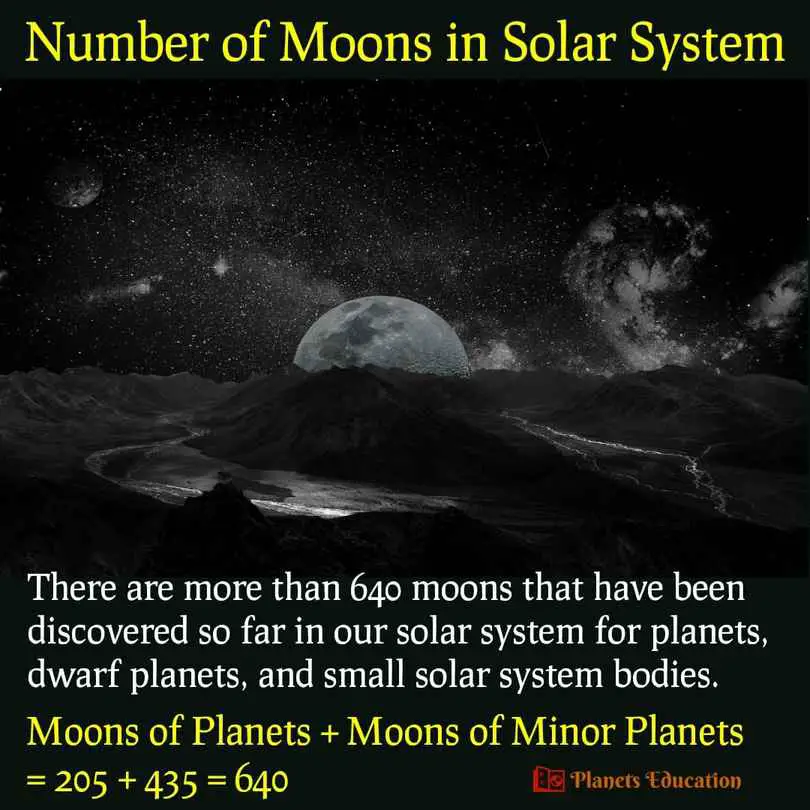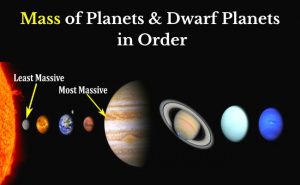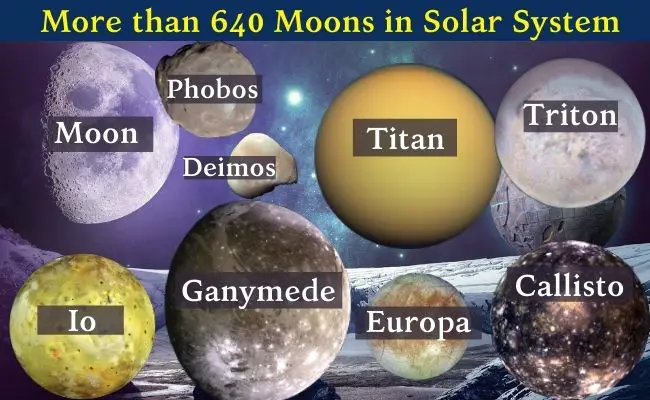There are a total number of 216 moons (natural satellites) in the solar system for Planets and Dwarf planets. All 8 planets have a total of 207 moons and all 5 dwarf planets have a total of 9 moons.
Some Possible Dwarf Planets and Minor Planets including Asteroids also have small moons.
Where some planets have no moon, some have many number of moons. Such as, Mercury and Venus have no moon. Whereas Jupiter and Saturn have multiple moons. Even the few Dwarf Planets including Pluto have multiple moons.
Many Possible Dwarf Planets and Asteroids also have their own moons, though they are comparatively small in size. So far till 2023, scientists have found 457 Minor Planets in our solar system that have a total of 477 moons. (Minor Planets = Dwarf Planets + Small Solar System Bodies).
So basically there are more than 684 natural satellites/moons that have been discovered so far in our solar system for planets, dwarf planets, and small solar system bodies.
Here in this article, we are going to get the list of the total number of moons in the solar system with some interesting facts and information.
Moons in the Solar System
We have categorized 3 lists for the total number of moons in the Solar System:
- Planets and their Moons list
- Dwarf Planets and Possible Dwarf Planets Moons list
- Minor Planet Moons list

Planets and their Moons list
There are 8 planets in our solar system and all 8 planets (Mercury, Venus, Earth, Mars, Jupiter, Saturn, Uranus, Neptune) have 207 natural satellites.
So how many moons our planets have…? There are 207 moons of planets that have been found by scientists so far… Though Mercury and Venus do not have any natural satellites.
Below are the list and names of the moons for all planets in our solar system:
Moons of Mercury: 0
Planet Mercury has no moon. This planet is very small and close to the sun, so it is almost impossible to hold any moon in its orbit. If it had any moon, then its moon would either collide with Mercury itself or pulled by Sun because of Sun’s high gravitational force.
Moons of Venus: 0
Planet Venus also does not have any moon.
But why does Venus have no moon? Venus is large enough to hold the moon in its orbit! But there are some possibilities, like if the moon’s position is too far from the planet then it would be pulled-in by Sun’s gravity. And if it’s too close to Planet, it would be destroyed by tidal gravitational force between moon and planet. So the moon should be within a particular region if it has to exist.
In between the two above-mentioned locations, there is some orbital place where it could hold a moon. And according to scientists Venus used to had a moon in the past that collided with another object.
Earth’s Moon: 1
The Earth has only one natural satellite, that is our ‘Moon’.
To know more about Earth’s Moon, here is an article especially for Moon of Earth with interesting facts and information:
| Earth’s Moon ⇓ |
Moons of Mars: 2
Mars has two moons: Phobos and Deimos.
To know more about Mars’s Moons, here is an article especially for Moons of Mars with interesting facts and information:
| Moons of Mars ⇓ |
Moons of Jupiter: 80
Jupiter has 80 moons or natural satellites. It is the largest planet in our solar system, so does it has the largest moon (Ganymede).
To know more about Jupiter’s Moons, here is an article especially for Moons of the largest world Jupiter with interesting facts, names, numbers, lists, sizes, and other information.
| 80 Moons of Jupiter ⇓ |
Moons of Saturn: 83
Planet Saturn has the most number of moons in the solar system. It has a total of 83 natural satellites. ‘Titan’ is the largest moon of Saturn and the second-largest moon of the solar system.
To know more in detail, here is an article especially for Moons of Saturn with interesting facts, names, number, lists, and other information:
| 83 Moons of Saturn ⇓ |
Moons of Uranus: 27
Uranus planet has a total of 27 moons that orbit around it. The largest Uranian moon is ‘Titania’.
To know more here is a special article for Moons of Uranus with interesting facts, names, number, size, list, and other information:
| Moons of Uranus ⇓ |
Moons of Neptune: 14
Planet Neptune has just 14 moons. Neptune’s largest moon is ‘Triton’, which is the seventh-largest moon in the solar system.
To know more about Neptune’s Moons, here is an article especially for Moons of Neptune with interesting facts, names, number, lists, size, and other information:
| Moons of Neptune ⇓ |
So the total number of Moons of all Planets are:- 0+0+1+2+80+83+27+14= 207
Dwarf Planets and Possible Dwarf Planets Moons list
There are 5 Dwarf Planets (IAU recognized) and many Possible Dwarf Planets in our solar system. So what are the Possible Dwarf Planets…? Possible Dwarf Planets are the Minor Planets that have characteristics of Dwarf Planets but not recognized by the International Astronomical Union (IAU) yet.
Check here: Dwarf Planets and Possible Dwarf Planets
So here is the table given for IAU recognized 5 Dwarf Planets and their moons list:
| 5 Dwarf Planets | Number of Moons |
| Ceres | 0 |
| Pluto | 5 |
| Haumea | 2 |
| Makemake | 1 |
| Eris | 1 |
Now here is the table for some Possible Dwarf Planets (most-likely dwarf planets) and their number of moons list:
| Possible Dwarf Planets | Number of Moons |
| Orcus | 1 |
| Salacia | 1 |
| Quaoar | 1 |
| Gonggong | 1 |
| Sedna | 0 |
So here you saw only Ceres and Sedna do not have any moon. These listed Dwarf Planets and Possible Dwarf Planets are in order of increasing distance from the Sun. Hence the interesting facts are, Ceres is the nearest and Sedna is the farthest on this list.
Thus the total number of moons of Dwarf Planets and Possible Dwarf Planets are:- (5+2+1+1)+(1+1+1+1)= 13
Minor Planet Moons list
The minor planet moons are small astronomical objects that orbit the minor planet. These moons are also known as ‘companions or satellites’.
There are millions of minor planets in our solar system. Minor planets are asteroids, dwarf planets, and other small solar system bodies. According to scientists, there may be thousands of minor planets that may have at least one moon.
By 2023 so far, there are almost 457 known minor planets that may have a total of 477 moons. In these 477 moons, some moons of binary asteroids and some moons of triple asteroids have been also added.
Ida was the first discovered asteroid that has a moon. Its moon name is Dactyl and it was discovered by Galileo spacecraft in 1993 when it flyby Ida.
Here a list of few asteroids is given with their moons names and size in diameter:
| Asteroids | Moons Names with Diameter |
| Ida (243 Ida) | Dactyl (Ida 1), 1.4 km |
| Sylvia | Romulus, 10.8 km |
| Remus, 10.6 km | |
| Eugenia | Petit-Prince, 7 km |
| S/2004 (45) 1, 5 km | |
| Kalliope | Linus, 28 km |
| Antiope | S/2000 (90) 1, 88 km |
| Hermione | S/2002 (121) 1, 32 km |
| Emma | S/2003 (283) 1, 9 km |
So these were few main asteroids and their moon names list with diameter. As mentioned few asteroids have multiple moons.
Conclusion for how many moons in the solar system?
Adding the moons is not a tough task, but scientists are continuously searching. So the list is continuously increasing.
So let me add all the moons of the solar system:
Moons of Planets + Moons of Minor Planets = 207 + 477 = 684
*Note – The minor planet moons list also includes the “dwarf planets and possible dwarf planets” moons list.
“Hence by 2022, there are almost 684 natural moons in the solar system have been discovered so far. In which our all planets has 207 moons, dwarf planets has 9 moons, possible dwarf planets have 4 moons, rest minor planets have”.
Frequently Asked Questions (FAQ):
What is the biggest moon in the solar system?
The biggest moon or largest satellite in our solar system is Ganymede. It is the moon of planet Jupiter. To know more about Ganymede, here check in detail: Ganymede Moon: Largest Moon of Jupiter
What is the second-largest moon in the solar system?
Titan is the second-largest moon of our solar system with almost 50% larger than the earth’s moon. It is the moon of planet Saturn.
What is the smallest moon in the solar system?
‘S/2009 S 1’ is a moonlet of Saturn and comes in the list of 82 moons of Saturn. It is the smallest moon of any planet in our solar system found so far. The diameter of “S/2009 S 1” is around 0.3 km (300 meters) only. Though there are many of Jupiter’s moons that have a diameter of around 1 km.
- 5 Best Solar System Backpacks in 2024

- Mass of Planets in Order from Lightest to Heaviest

- Star Projector {2024}: Star Night Light Projector


